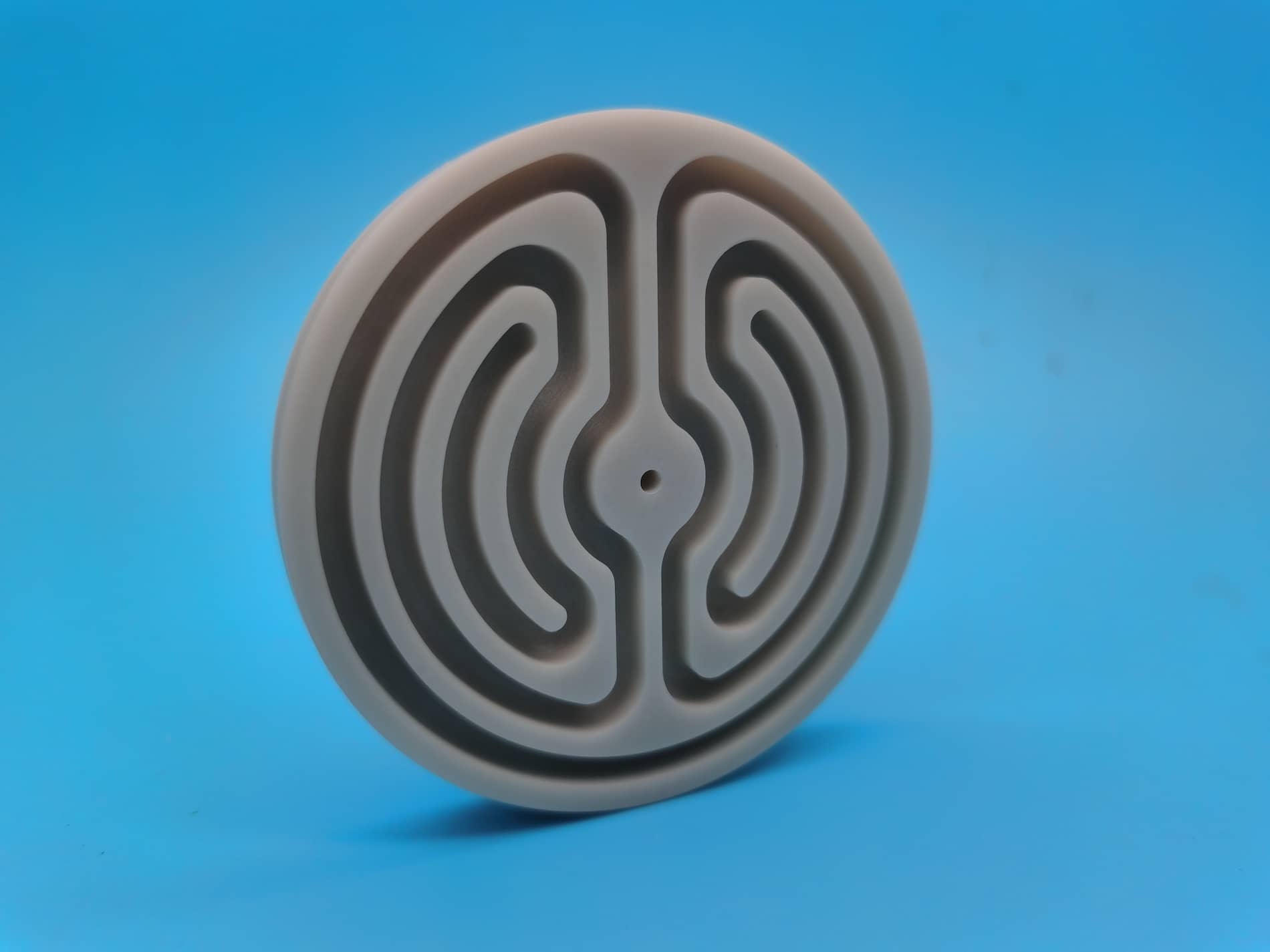Aluminium Nitride: Key Properties and Applications
Xiamen Innovacera Advanced Materials Co., Ltd
Aluminium nitride (AlN) is a non-oxide technical ceramic. It is well known for its combination of very high thermal conductivity, resistance to high temperatures and as an electrical insulator. For this reason, it is often used as a heat sink or as a substrate for electronics where a high thermal conductivity is required, for example for LEDs and semiconductors.
The most important properties and applications of aluminium nitride are outlined below.
Properties of aluminium nitride
Aluminium nitride’s functionality comes from its combination of thermal, electrical and mechanical properties.
Structural properties
Aluminium nitride has the chemical formula AlN. It is a covalently bonded inorganic compound with a hexagonal wurtzite crystal structure. It has a density of 3.3 g/cm3 and a molar mass of 40.99 g/mol.
Thermal properties
In contrast to most ceramics, aluminium nitride has a very high thermal conductivity. In fact, AlN has one of the highest thermal conductivities of any ceramic, surpassed only by beryllium oxide. For monocrystalline AlN, this value can reach as high as 285 W/(m·K). For polycrystalline material, however, a value in the range of 70–210 W/(m·K) is more common.
The high thermal conductivity of aluminium nitride is a result of its low molar mass (40.99 g/mol compared to 101.96 g/mol for alumina, Al2O3), strong bonding and relatively simple crystal structure. More of the properties of aluminium nitride are compared to other similar technical ceramics below.
Aluminium nitride exhibits a coefficient of thermal expansion of 4.8✕10-6 1/K at 20 °C. This is similar enough to that of silicon (3.5✕10-6 1/K at 20 °C) that AlN is often used as a substrate material for silicon processing.
Additional properties of aluminium nitride relevant for use at elevated temperatures are high thermal shock resistance and resistance to corrosion from molten metals, chemicals and plasmas at high temperatures.
Aluminium nitride has a melting temperature of 2200 °C and a boiling point of 2517 °C.
Electrical properties
Similar to other ceramics, AlN has a very high electrical resistivity, in the range of 10-16 Ω⋅m. This makes it an electrical insulator.
AlN also has a relatively high dielectric constant of 8.8-8.9 (for pure AlN), which is a similar value to that of Al2O3, but much lower than SiC.
The breakdown electric field of AlN is 1.2–1.8 x 106 V cm-1.
AlN also displays piezoelectricity, which is useful in thin film applications.
Mechanical properties
AlN has a flexural strength of 350 MPa at 20 °C, which is the same as Al2O3 and just lower than that of SiC.
It has a high Young’s modulus of 343 GPa, compared to in the 200 GPa range of steel. This value is just lower than that of Al2O3.
AlN also has a high Vickers hardness of around 1000 at 20 °C.
Aluminium nitride compared to other common ceramics
Below is a comparison table of some of the relevant properties of some popular technical ceramics, including aluminium nitride.
|
Property |
AlN |
SiC |
BeO |
Al2O3 |
|---|---|---|---|---|
|
Thermal conductivity W/(m·K) at 20 °C
|
170–210 |
150 |
250–300 |
20–30 |
|
Coefficient of thermal expansion at 20 °C |
4.3–4.8 |
3.7 |
7.5–8.0 |
6.7–7.3 |
|
Dielectric constant |
8.8–8.9 |
40–42 |
6.5–6.7 |
8.5–8.9 |
|
Electrical resistivity (Ωcm) |
>1014 |
>1014 |
>1014 |
>1014 |
|
Density (g/cm3) |
3.26 |
3.21 |
3.01 |
3.97 |
|
Flexural strength (MPa) |
350 |
370 |
240 |
350 |
|
Young’s modulus (GPa) |
343 |
460 |
378 |
378 |
Applications of aluminium nitride
The high temperatures present in semiconductor manufacturing processes combined with the sensitivity of the devices under fabrication make aluminium nitride particularly useful as a substrate material. Its high thermal conductivity allows it to act as an excellent heat sink while remaining electrically insulating and not fracturing under high temperatures. In addition, it has a very similar coefficient of thermal expansion to silicon.
AlN is a common alternative to beryllium oxide in similar applications, as it is not a health hazard when machined.
As a result of its high resistance to corrosion at high temperatures, AlN is also used as a crucible material for molten metals.
In the form of thin films, AlN has a number of applications. As a result of its piezoelectrical properties, it is used for surface acoustic wave (SAW) sensors. It is also used for thin film bar acoustic resonators (FBAR), a microelectromechanical system (MEMS) device used for RF filters in mobile phones. Research is also underway to develop gallium-aluminium nitride-based light-emitting diodes.
Some other common applications of AlN include:
- Heat spreaders
- Packages for microwave devices
- Molten metal fixtures
- Components for laser heat management
- Electrical insulation components for lasers
- Substrates for electronic packages
- Substrates for microelectronic & optoelectronic devices
- Insulators for microelectronic & optoelectronic devices
- Chip carriers for sensors and detectors
- Chiplets
- Collets
- Silicon wafer handling and processing
- Electrical insulators
- Chucks and clamp rings for semiconductor processing equipment
- Steel manufacturing equipment

Aluminium nitride parts. Credit: Innovacera
Processing of aluminium nitride
Aluminium nitride is a non-naturally occurring material and so must be chemically synthesized. It is formed via one of two processes. This first is the carbothermal reduction of aluminium oxide, Al2O3, in the presence of nitrogen gas or ammonia at a temperature of 1400–1700 °C. The reaction involving nitrogen is as follows:
1. Al2O3 + C → Al2O2 + CO
2. Al2O2 + 2C + N2 → 2AlN + 2CO
The second synthesis process is the direct nitridation of aluminium.
AlN parts can be formed by a number of routes, including:
- Ceramic injection moulding
- Low-pressure injection moulding
- Cold isotactic press
- Dry press
- Tape casting
- Precision machining
Following synthesis, and the formation of parts, the material is usually sintered. Sintering aids such as calcium oxide, CaO or yttrium oxide, Y2O3 are often added to enhance is sintering densification process.
Sourcing aluminium nitride
For the processing of advanced products such as semiconductors, high-quality materials are a necessity. Material selection is a fundamental step, and finding the right material is no easy task. Luckily, material suppliers, such as Xiamen Innovacera Advanced Materials, provide a broad spectrum of high-quality technical ceramic materials, including aluminium nitride. They have listed their materials here on Matmatch to ensure that engineers, researchers, and product developers can easily find their desired materials and reach out to them directly.
Visit the Xiamen Innovacera Advanced Materials supplier page for more information on their materials and to get in direct contact with them.
Article by Xiamen Innovacera Advanced Materials Co., Ltd
INNOVACERA engages in R&D, manufacturing and selling the products of advanced ceramic materials, including Alumina, Zirconia, Boron Nitride, Silicon Nitride, Machinable Glass Ceramic and other advanced materials.
Our products are mainly used in Aerospace, Research, Food Processing, Fluid Handling, Scientific, Automotive, Defense, Thermal Processing, Electronic and Electrical, Process Control, Textile, Pulp and Paper, Mechanical, Glass Processing, Mineral Processing and other Industrial applications.

